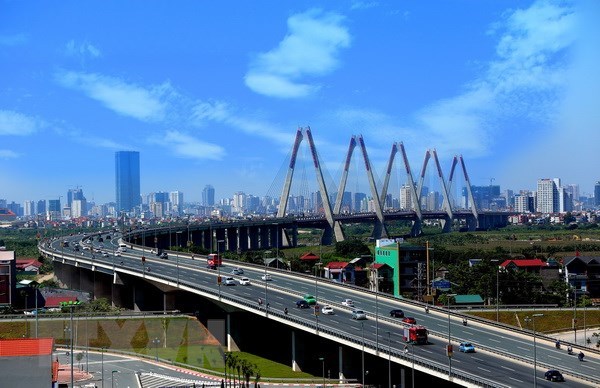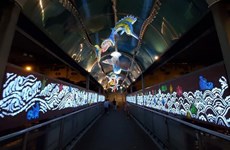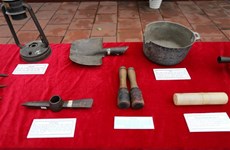New look for Hanoi 10 years after expansion
Hanoi has reportedly undergone considerable changes in its economic growth, appearance and infrastructure a decade on from the administrative boundary expansion.
 A view of Nhat Tan Bridge in Hanoi (Photo: VNA)
A view of Nhat Tan Bridge in Hanoi (Photo: VNA)Hanoi (VNS/VNA) - Hanoi has reportedly undergone considerable changes in its economic growth, appearance and infrastructure a decade on from the administrative boundary expansion.
The economic growth rate reaches 7.41 percent each year on average during 2008-18.
The gross regional domestic product (GRDP) per capita in 2017 was 2.3 times higher than 2008. The gross domestic product (GDP) per capita in 2017 reached 3,910 USD, twice as high compared to 2008.
It was revealed by Deputy Director of the city’s Planning and Investment Department Vu Duy Tuan at a press conference on July 24 to prepare for the 10th anniversary of Hanoi’s administrative boundary expansion.
Additionally, the growth rate of the industrial sector usually stays stable at an average of 8.61 percent each year.
The sector’s revenue in 2017 reached 6.5 billion USD, 2.5 times higher than in 2008.
The city welcomed 4.95 million overnight visitors in 2017, about 2.8 times higher than in 2008. Hanoi was also listed among the world’s top 10 fastest growing tourism cities in 2017 by Mastercard Global Services.
According to Tuan, Hanoi’s area only accounts 1 percent of the total area of the country but the city contributes more than 19 percent to the State budget.
Aiming to build a modern capital city, Hanoi has also focused efforts on creating new-style rural areas and gaining remarkable achievements, one of which is reducing the gap in living conditions between urban and rural areas.
During the past decade, per capita income in rural areas increased threefold between 2008 and 2017, reaching 38 million VND a year in 2017.
The capital now has a new and dynamic look as every metropolis in the world after ten years of growth.
A number of new and modern urban areas have been constructed to serve a growing demand of city dwellers, including My Dinh, Linh Dam, Van Quan, Viet Hung, An Khanh, Ciputra, Times City, and Royal City.
A series of modern and large-scale infrastructure projects have been completed during the period, including the elevated Belt Road No 3, the Nhat Tan – Noi Bai Highway, the extended National Road No 5, several new bridges across the Hong (Red) River and seven flyovers in the city, contributing greatly to easing traffic congestion.
The city plans to boost development to the north with the Kim Quy (Golden Turtle) Amusement Park, covering more than 100ha in Dong Anh district.
The park is expected to reach global levels with an investment of thousands of billions of dong; and the National Exhibition Centre in Dong Anh district, which is expected to become the Asia’s largest, and the world’s fifth largest, exhibition and fair complex when it opens.
Despite these major achievements, Hanoi still faces several challenges such as reducing overload for inner-city hospitals, depopulation of inner districts and creating more jobs for unemployed people.
Speaking at the press conference, Ngo Van Quy, Vice Chairman of the People’s Committee of Hanoi, said improving the quality of hospitals in the suburbs was a way to reduce pressure at inner-city hospitals.
In the meantime, dealing with issues like tap water and waste
treatment in suburban districts were also the first steps to implement the plan
to depopulate inner districts, he said.
The city is scheduled to open three tap-water supply factories to ensure all suburban people have tap water by 2020.
Connecting infrastructure from the city’s downtown to suburban districts would help boosting the depopulation plan, he added.
The city is scheduled to open three tap-water supply factories to ensure all suburban people have tap water by 2020.
Connecting infrastructure from the city’s downtown to suburban districts would help boosting the depopulation plan, he added.
To do that, the city would construct more radial roads
linking the inner districts to the suburbs, he said.
At present, the city hopes to create jobs for 152,000 people, reducing the unemployed rate to below 4 percent in 2018.
Quy said the city has focused on raising both quality and quantity of jobs.
The expansion of administrative boundary carried out under the 12th National Assembly’s Resolution 15/2008/QH12 in 2008, was a historic event with long-term and comprehensive impacts and influence on the capital city’s political, economic and social situation.
After merging with the whole neighbouring Ha Tay province, Me Linh district of Vinh Phuc province and four communes of Luong Son district, Hoa Binh province, the current Hanoi stretching over 3,328 sq.km, tripling the former acreage. The city has 577 communes, districts and townships of 29 districts and towns.-VNS/VNA
At present, the city hopes to create jobs for 152,000 people, reducing the unemployed rate to below 4 percent in 2018.
Quy said the city has focused on raising both quality and quantity of jobs.
The expansion of administrative boundary carried out under the 12th National Assembly’s Resolution 15/2008/QH12 in 2008, was a historic event with long-term and comprehensive impacts and influence on the capital city’s political, economic and social situation.
After merging with the whole neighbouring Ha Tay province, Me Linh district of Vinh Phuc province and four communes of Luong Son district, Hoa Binh province, the current Hanoi stretching over 3,328 sq.km, tripling the former acreage. The city has 577 communes, districts and townships of 29 districts and towns.-VNS/VNA













